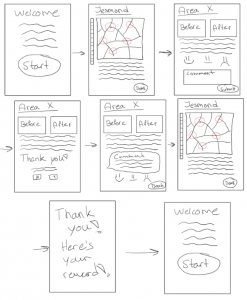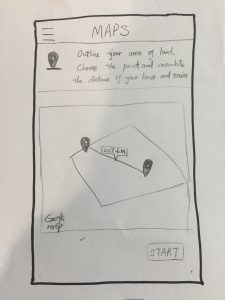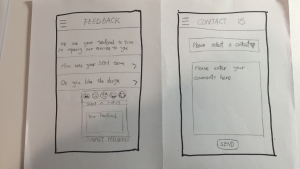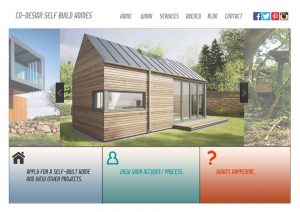This week we made a lot of advancements from the previous week as we felt we couldn’t really move forward without meeting our mentor. When we met with Peter he guided us on power dynamics as something major we need to consider- do community feel safe expressing their views to a large, intimidating company? Will their voices be heard? Will their views and opinions be twisted? David also expressed concerns over transparency- how much will be released to the public? Will anything be held from public? Regarding the app he suggested a few things for us to consider:
- A reference/scrutiny group to sign things off from developers before posting on the site and approve comments from residents before they go live
- Is it possible to have a framework? Each development is different
- Developers digitised proposals make it easy for them to gloss over more difficult/controversial parts of the scheme- we need to be aware of that and keep up level of transparency
- Always going to be controversy and challenge around new developments- has potential to cause more dispute
- WHO IS YOUR AUDIENCE?
From the meeting and time spent as a group we had began to perfect our ideas and think more in depth about the exact features of our app. Another main point is the we had previously been calling the group of people we wanted to engage with ‘hard to reach’ and from our mid term presentation it was pointed out that how could we engage with all these different groups of people with one app when they all have different needs. We came to the decision that we would be focusing our app on the groups of people that already show an interest in planning but due to current procedures they cannot express how they feel. Now our aim was to focus on people that wanted to engage but couldn’t rather than get more people engaged because you can’t really engage someone if they don’t want to be engaged. From this we had a clear focus and could begin to start thinking of how we would design our app.
Atlanta Community Engagement Playbook:
Inspirations for the app came from literature and ideas around the world and we could really start to get specific in what we wanted. One very helpful literature was about the Atlanta Community Engagement PlayBook which is designed for Atlanta one of the fastest growing cities in USA to engage communities to facilitate constructive engagement and to mobilise community-led development and change. The long-term goal is to offer community associates and service providers a set of actionable practices to achieve greater levels of quality engagement. We selected this as one of our main inspirations as we would be associated more closely with being a ‘service provider’, but some of the principles behind the plays for community associations are what we are trying to include within the app (e.g. creating a community led vision for change; creating an inviting and open platform for community members to rally around; and weaving elements of fun and culture the practice). The long-term goals of the playbook is similar to our long-term goal as we want to create a tool that will actually alter the current practices, however we are going down the route of the app rather than more community based projects. This makes it easier for us to involve all the members of the community that wish to be involved. Some of the action guides provide useful methods for some practices, we have used, and could still use, some of these guides when going through the processes of mapping, sketching, deciding, prototyping, and testing.
Playing with Empathy: Digital Role-playing games in Public Meetings
This literature was a study of the implementation of a game called participatory Chinatown a 3D multiplayer game designed to be played in the physical space of planning meeting in Bostons Chinatown neighbourhood. The reading helped us to understand how role-play can affect the way people understand issues and engage and looks at challenges of extracting player empathy from gameplay to a larger context that can then be studied and implemented. Some features include augmented deliberation like debating while playing as character in 3D virtual world (not necessarily as themselves) enchancing empathy, which is needed for group cooperation. There were high scores at the end for discussion where the discussion moderator asks people (using characters name) on how they felt about results this prompted discussion about competition, trade-off, lack of resources, transportation. Participatory Chinatown demonstrates that role-play can engage players in local issues and motivate engagement. However its making people aware of how the framework acts outside the game when you cannot score points. We used some extractions from this document rather than the framework of the game. Our target audience is not people that have a lot of time on their hands and would not really engage in something that required so much effort as going somewhere and walking around. However from this we learnt that the whole idea of visually seeing something and being able to walk around it and see all elements really helped with engagement. From this we started to develop ideas about a map feature in our app that would allow users to physically see the development locations and scroll around to see exact details. Also the importance of the discussion aspect, in our app rather than promote a huge conversation between everyone which could go off topic we are thinking about more of a news feed of everyone different comments so everyone feels their voices are heard.
Second life:
This idea is advanced logging (collection of data) techniques to capture the interactions of the user with the virtual environment to generate a log i.e. what people look for in a CAD imagine or where they go in a game. This is then brought together to create an approximate estimation of real user interaction with the project in real life. It can produce design ideas and amendments from planners and users of the programme. Second Life gives a running account of user experience with the project as it starts and moves on, giving planners better and more comprehensive ideas for the use of space. Second Life puts users in a virtual world in the place of an avatar or a playable character, users walk through and interact with the space and the objects within it. Users can see how the new development will look or show how they interacted with the old site and information is collected from both. We took a lot of inspiration for this as it really showed that ICT is becoming ever more vital for urban planning in 21st century but there is some worry about more local communities being overlooked in favour of more global and further reaching initiatives so we realised the importance of focusing on the local. From this we decided to make everything user specific so that the community felt that this application had been made for them and tailored to there needs which we had gathered from our stakeholder meetings. But also heavily featured these ICT features that are fairly new and we new we wanted the make something modern and innovative. It showed us that to visualise it there needs to be a feature of the virtual environment we have continually seen pop up to stay with the times.
We look forward to start defining and perfecting our ideas.



 **
**


